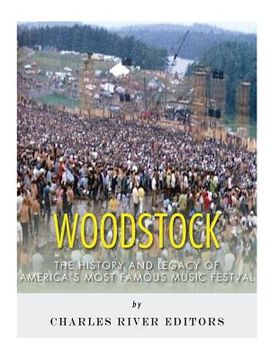Woodstock: The History and Legacy of America's Most Famous Music Festival (en Inglés)
Reseña del libro "Woodstock: The History and Legacy of America's Most Famous Music Festival (en Inglés)"
*Includes pictures. *Explains how the festival was put together and highlights the performances. *Includes footnotes and a bibliography for further reading. "We were ready to rock out and we waited and waited and finally it was our turn...there were a half million people asleep. These people were out. It was sort of like a painting of a Dante scene, just bodies from hell, all intertwined and asleep, covered with mud. And this is the moment I will never forget as long as I live: a quarter mile away in the darkness, on the other edge of this bowl, there was some guy flicking his Bic, and in the night I hear, 'Don't worry about it John. We're with you.' I played the rest of the show for that guy." - John Fogerty of Creedence Clearwater Revival Woodstock, more accurately entitled the Woodstock Music Festival; An Aquarian Exposition: Three Days of Peace and Music, represents one of the most enduring symbols of the Youth Movement of America's late 1960s and early '70s. As the public pinnacle of that social phenomenon, the giant festival that overwhelmed a section of an upstate New York farm for a week during a time of national and international upheaval evolved from a typical speculative financial venture to a defining historical monument thanks to the legendary performances by many of the era's greatest musicians. The now iconic festival all began with an advertisement in The New York Times taken out by four financial investors. Michael Lang was the manager of a rock band, and Artie Kornfeld served as an executive for Capitol Records, a major label of the time for both classical and non-classical music. Joined by capitalists John Roberts and Joel Rosenman, the ad read simply, "Young men with unlimited capital looking for interesting, legitimate investment opportunities and business propositions." The original idea called for the construction, maintenance and management of a recording studio in the Bethel, Wallkill and Woodstock areas, close to where Bob Dylan and a group called The Band lived. The picturesque setting was first envisioned as a retreat for rock artists, and no thought at all was given to such a prodigious event as the festival that followed. If a live performance was to be held, it would have been staged as a one-day promotion for the studio. All of this gave way to the larger concept, in part inspired by the Monterey Pop Festival of 1967, the largest of its kind to that point. The working title of the new rock festival took a similarly different approach from what inevitably resulted, originally dubbed the Woodstock Music and Art Fair. A long search ensued, based on cost and crowd estimates that, in the end, turned out to be more than overly-conservative. Of course, nobody involved would have originally guessed that the event would include participants like Janis Joplin, Jimi Hendrix, The Who, Grateful Dead, Creedence Clearwater Revival, Jefferson Airplane and dozens of other acts over several days. By music festival standards, the audience at Woodstock was biblical in size, but the largest audience in festival history consists of those who claimed they were there. The closing decades of the 20th century abounded with countless claims by Baby Boomers who said that they had been among the mass that descended upon the New York farming community. In truth, Woodstock was a three-day, muddy logistical nightmare, as ill-prepared hippies arrived at an equally ill-prepared site with limited food supplies and even more limited access to restrooms. Ironically, as the music festival ballooned beyond anyone's expectations, it defeated the original purpose of the organizers. As John Roberts explained before Woodstock had even ended, "If we had any inkling that there was going to be this kind of attendance, we certainly would not have gone ahead...Financially speaking, of course, the festival is a disaster."

